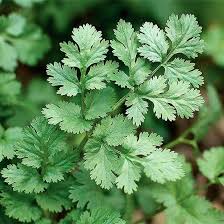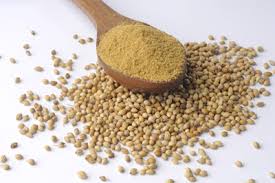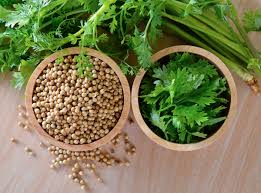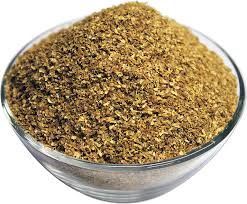Coriander Spice, also known as cilantro or Chinese parsley, is a popular Spice or herb that adds a delightful flavor to a wide variety of dishes. It comes from the coriander plant, which produces both the spice and the fresh leaves, each with its unique taste and uses.
Coriander spice is made from the seeds of the coriander plant. These seeds have a warm, citrusy flavor with hints of both sweet and savory notes. They are commonly used in cooking to enhance the taste of curries, soups, stews, and various other dishes. Coriander spice can be ground into a fine powder or used whole, depending on the recipe.
In some cuisines, coriander spice is a key ingredient in spice blends like curry powder and garam masala. Its distinctive flavor adds depth to these mixtures, creating a harmonious blend of spices that contribute to the overall taste of the dish. Coriander spice is also often used to season meat and poultry, giving them a delicious and aromatic profile.
Apart from its flavor-enhancing properties, coriander spice has been valued for its potential health benefits. It contains antioxidants that may help reduce inflammation in the body. Additionally, some studies suggest that coriander seeds could have antimicrobial properties and may aid in digestion.
Coriander spice is used in both traditional and modern cooking, connecting generations through the love of its flavor. It’s an essential ingredient in many global cuisines, from Indian and Mexican to Middle Eastern and Southeast Asian. The spice has a versatile nature, allowing it to complement both sweet and savory dishes.
In addition to its culinary uses, coriander spice has found its way into various cultural practices. In some cultures, it’s used for its purported medicinal properties, such as aiding in digestion or relieving minor ailments. Its fresh leaves, known as cilantro, are often used as a garnish or incorporated into salads and salsas to provide a burst of fresh, tangy flavor.
In addition, Coriander Spice is a remarkable ingredient that has earned its place in kitchens worldwide. Its warm, citrusy taste and versatility make it an excellent addition to countless dishes, while its potential health benefits further enhance its appeal. Whether used as a seasoning, spice blend component, or for its cultural significance, coriander spice continues to be an integral part of global cuisine.
Read Also: Full Sun Flowers: All You Need To Know About
How to Grow Coriander Spice

Here’s a simple growing guide for coriander, a versatile spice that’s great to cultivate in your garden:
Step 1: Choose the Right Location: Select a spot that receives partial to full sunlight. Coriander prefers well-drained soil that’s rich in organic matter.
Step 2: Planting: You can grow coriander from seeds. Directly sow the seeds into the soil about 1/4 to 1/2 inch deep. Space the seeds around 6 to 8 inches apart. If you’re planting in pots, use a pot with good drainage and sow a few seeds in each pot.
Step 3: Watering: Keep the soil consistently moist, but not waterlogged. Water the plants when the top inch of soil feels dry. Be careful not to overwater as coriander doesn’t like soggy conditions.
Step 4: Thinning: Once the coriander seedlings have grown a few inches tall, you may need to thin them out. Leave about 3 to 4 inches of space between each seedling. This will allow the plants to have enough room to grow.
Step 5: Fertilizing: You can apply a balanced fertilizer once a month to encourage healthy growth. Avoid over-fertilizing, as it might result in excessive leafy growth with less flavor.
Step 6: Harvesting: Coriander leaves can be harvested when they are large enough, usually around 3 to 4 inches long. You can snip off the outer leaves and allow the inner ones to continue growing. The seeds can be harvested once the plant starts producing flowers and the seeds turn brown. Cut the seed heads and allow them to dry in a well-ventilated area.
Step 7: Pests and Diseases: Keep an eye out for aphids, whiteflies, and other common pests. You can use natural insecticides or remove them manually. Proper spacing and good air circulation can help prevent diseases.
Step 8: Successive Planting: To have a continuous supply of coriander, consider sowing seeds in batches every few weeks. This will ensure you have a steady harvest throughout the growing season.
Step 9: Storing: Fresh coriander leaves can be stored in the refrigerator for a few days. To store coriander seeds, make sure they are completely dry and store them in an airtight container in a cool, dark place.
Step 10: Enjoying Your Harvest: Use freshly harvested coriander leaves to garnish dishes, make sauces, or add flavor to your cooking. Coriander seeds can be ground and used as a spice in various recipes.
Remember, coriander has a tendency to bolt (flower and produce seeds) quickly, especially in warm weather. By providing the right conditions and staying attentive to its growth stages, you can enjoy a bountiful harvest of this flavorful herb.
12 Health Benefits of Coriander Spice

Here are 12 potential health benefits associated with consuming coriander spice:
1. Digestive Aid: Coriander spice contains compounds that may aid digestion by stimulating digestive enzymes and promoting proper bowel movements.
2. Anti-Inflammatory Properties: The antioxidants in coriander spice, such as quercetin, may help reduce inflammation in the body, potentially benefiting conditions like arthritis and inflammatory disorders.
3. Blood Sugar Regulation: Some studies suggest that coriander spice may help regulate blood sugar levels by increasing insulin secretion and improving insulin sensitivity.
4. Cholesterol Management: Coriander spice might contribute to healthy cholesterol levels by lowering LDL (bad) cholesterol and increasing HDL (good) cholesterol.
5. Heart Health: The combination of antioxidants and other beneficial compounds in coriander spice may support heart health by reducing oxidative stress and improving overall cardiovascular function.
6. Antimicrobial Effects: Coriander spice contains natural antimicrobial compounds that may help fight against certain bacteria and fungi, contributing to improved immune function.
7. Brain Health: Coriander spice’s antioxidants, such as beta-carotene, may have a protective effect on brain cells, potentially reducing the risk of cognitive decline.
8. Skin Health: The detoxifying properties of coriander spice, along with its potential to reduce inflammation, might lead to healthier skin and help manage skin conditions.
9. Allergy Relief: Some components of coriander spice may act as natural antihistamines, offering relief from allergy symptoms like sneezing and congestion.
10. Bone Health: Coriander spice contains essential minerals like calcium, which is crucial for maintaining strong bones and preventing bone-related disorders.
11. Aiding Sleep: Coriander spice is believed by some to have calming properties that could potentially aid in promoting better sleep and managing sleep disorders.
12. Digestive Disorders: The essential oils present in coriander spice may help soothe the digestive tract, providing relief from discomfort caused by digestive issues.
While these potential health benefits are suggested by various studies, it’s important to note that individual responses can vary. Incorporating coriander spice into a balanced diet along with consulting a healthcare professional for personalized advice is recommended.
Coriander Cilantro

Coriander Cilantro, a flavorful herb known for its fresh and tangy taste, is a versatile ingredient used in cooking around the world. This herb is also referred to as simply “cilantro” or “Chinese parsley.” It is popular for its unique ability to bring a burst of vibrant flavor to dishes, whether they are savory or slightly sweet.
Coriander Cilantro leaves are widely appreciated for their role in enhancing the taste of various dishes. From soups and salads to curries and salsas, this herb adds a zesty and refreshing note that awakens the palate. When chopped finely, its bright green leaves become a fantastic garnish, adding both a pop of color and a delightful aroma to the meal.
Coriander Cilantro is a special herb because not only its leaves but also its seeds are used in cooking. The seeds have a different taste compared to the leaves. They are earthy and warm, with a hint of citrus. Ground coriander seeds are commonly found in spice blends, adding depth to curries and other dishes. This two-in-one nature of coriander makes it a staple in many global cuisines.
For those with green thumbs or even just a small garden or windowsill, growing coriander cilantro is an exciting adventure. The herb can be cultivated from its seeds, which should be sown in well-draining soil. Regular watering and sunlight are key to its growth. Once it’s ready, you can simply snip off the leaves as you need them, ensuring a steady supply of fresh, aromatic coriander cilantro.
Coriander cilantro has a place not only in the culinary world but also in cultural traditions. It’s used in a variety of cuisines, from Indian and Mexican to Thai and Middle Eastern. In some cultures, it’s believed to have medicinal properties, aiding digestion and offering relief from minor ailments.
Interestingly, while many people adore coriander cilantro’s taste, there are some who find its flavor overpowering and even soapy. This phenomenon is believed to be linked to genetics, as certain individuals have taste receptors that interpret the herb differently.
Coriander Cilantro, with its vibrant leaves and aromatic seeds, is a true culinary wonder. Its versatility, from being a garnish to a spice, brings dishes to life. Whether you’re enjoying a zesty salsa, a fragrant curry, or a fresh salad, coriander cilantro is sure to play a role in making your meals even more delightful. So, the next time you savor its tangy goodness, remember the herb’s journey from soil to plate, adding its unique touch to the world of flavors.
Coriander Seeds

Coriander seeds are the small, spherical fruits that come from the coriander plant (Coriandrum sativum). These seeds, often used as a spice, have a distinct flavor profile that sets them apart from other spices. They have a warm, citrusy taste with subtle notes of sweetness and earthiness.
Coriander seeds are a common ingredient in many cuisines worldwide. They are known for their versatility, adding depth of flavor to both savory and sweet dishes. These seeds are used whole or ground, depending on the recipe. When roasted or toasted, they release a more intense aroma and flavor.
One of the notable roles of coriander seeds is their presence in various spice blends. They are a crucial element in popular blends like curry powder and garam masala. The addition of coriander seeds contributes to the overall complexity and balance of flavors in these mixtures.
In savory dishes, coriander seeds can be lightly crushed or ground and used as a seasoning for meats, poultry, vegetables, and rice. They are also often used in pickling brines and marinades. In some cuisines, coriander seeds are sautéed in oil or ghee at the beginning of cooking to release their aroma and infuse the base flavors of the dish.
Coriander seeds not only enhance the taste of dishes but also offer potential health benefits. They contain antioxidants that may help combat oxidative stress in the body. Additionally, some studies suggest that coriander seeds might have anti-inflammatory and antimicrobial properties, contributing to overall wellness.
Coriander seeds are known for their digestive properties. They may help alleviate digestive discomfort and promote healthy digestion by stimulating enzymes and aiding in the breakdown of food.
Beyond culinary uses, coriander seeds have been used traditionally for their potential medicinal benefits. They have been employed in various cultures to treat digestive issues, bloating, and gas. Some believe that coriander seeds can have a calming effect on the body.
Coriander seeds are a versatile and flavorful spice that has earned its place in kitchens worldwide. From enhancing the taste of dishes to offering potential health benefits, these small seeds play a significant role in both traditional and modern culinary practices. Whether they’re adding complexity to a curry or providing a unique twist to a marinade, coriander seeds continue to be a beloved and essential ingredient in global cuisine.
Read Also: Antirrhinum Flowers: All You Need To Know About
Ground Coriander

Ground coriander is a spice that comes from the seeds of the coriander plant (Coriandrum sativum). These seeds are dried and then finely ground into a powder, creating ground coriander. This spice offers a unique and versatile flavor that enhances a wide range of dishes.
Ground coriander has a warm and citrusy flavor, with a hint of sweetness and earthiness. It lacks the intense citrus punch of fresh coriander leaves (cilantro), making it suitable for both savory and slightly sweet recipes.
Culinary Uses
Ground coriander is a staple in many cuisines around the world. It’s used in both traditional and modern cooking to add depth of flavor and complexity to various dishes. This spice is commonly found in spice blends, contributing to the overall taste and aroma of the mixture.
1. Curries and Stews: Ground coriander is a common ingredient in curry powders and spice mixes used in curries and stews. Its mild, balanced flavor enhances the overall taste of these dishes.
2. Marinades and Rubs: Many cooks use ground coriander in marinades and rubs for meat, poultry, and fish. It imparts a subtle yet distinctive taste that complements the other flavors in the dish.
3. Breads and Baked Goods: Ground coriander can also be found in bread recipes and baked goods. It adds a subtle aromatic note that pairs well with the other ingredients.
4. Pickles and Chutneys: This spice is often used in pickling brines and chutneys, providing a unique and complementary flavor.
Just like whole coriander seeds, ground coriander also offers potential health benefits. It contains antioxidants that may help reduce oxidative stress in the body. Additionally, ground coriander can aid digestion and promote healthy gut function.
When using ground coriander, a little goes a long way. It’s advisable to start with a small amount and adjust according to taste. You can toast the ground coriander in a dry skillet for a few seconds to enhance its flavor before adding it to dishes.
If you find yourself out of ground coriander, you can consider substituting it with a mix of cumin and orange zest. While this won’t replicate the exact flavor, it can offer a similar warm and citrusy note.
Ground coriander is a versatile spice that brings a distinct flavor to a wide range of dishes. Its warm, citrusy taste can transform ordinary recipes into extraordinary culinary delights. Whether you’re spicing up a curry or adding depth to a marinade, ground coriander remains an essential ingredient in kitchens around the globe.
Read Also: Styrofoam Recycling Comprehensive Guide
